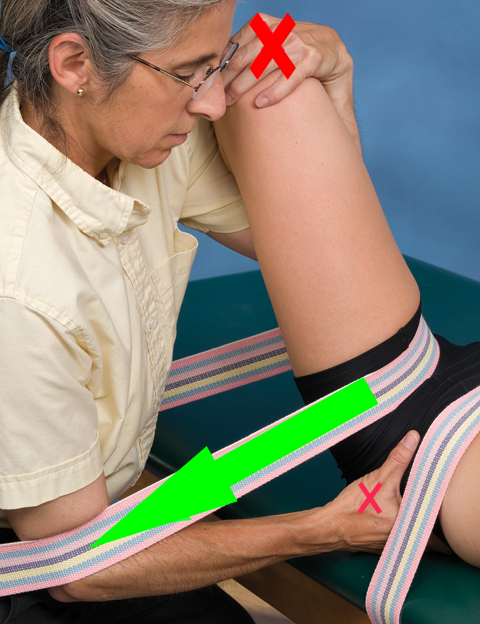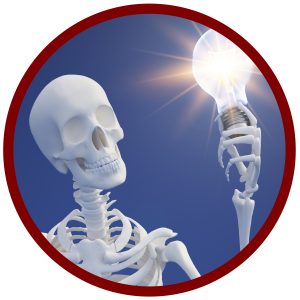

Hip Mobilization Techniques
Activities of daily living requires a significant amount of hip mobility. Failure to have sufficient hip mobility can result in unnecessary stress on the lower back or lower extremities. Performing the appropriate hip arthrokinematic techniques can help restore normal range of motion. This blog will discuss 5 mobilization techniques for the hip, the motions they facilitate, and the methods used to perform them. The 5 techniques are:
-
-
- Inferior glide
- Anterior glide
- Posterior glide
- Medial glide
- Lateral glide
-
All of these glides should be preceded by a slight amount of joint distraction to reduce the amount of osseous compression during the mobilization. Joint distraction is a motion that is perpendicular to the joint surfaces.
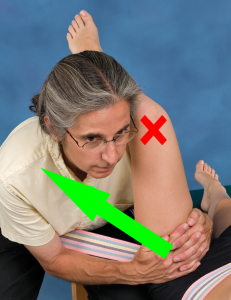 Hip Inferior Glide is used to improve hip flexion. The technique is performed in supine with the hip flexed to 90°. The clinician’s hands can be clasped at the superior proximal femur or a mobilization strap can be used to enhance grip and reduce sliding on client’s skin. The clinician can simply lean back to impart an inferior force to the femur with a counterforce of the shoulder on the distal femur. If the client finds the strap uncomfortable, the clinician can weave their hands under the strap so the clinician’s hands are on the client’s skin and the strap is on the clinician’s hands. This latter option may also help the clinician “feel” the motion better.
Hip Inferior Glide is used to improve hip flexion. The technique is performed in supine with the hip flexed to 90°. The clinician’s hands can be clasped at the superior proximal femur or a mobilization strap can be used to enhance grip and reduce sliding on client’s skin. The clinician can simply lean back to impart an inferior force to the femur with a counterforce of the shoulder on the distal femur. If the client finds the strap uncomfortable, the clinician can weave their hands under the strap so the clinician’s hands are on the client’s skin and the strap is on the clinician’s hands. This latter option may also help the clinician “feel” the motion better.
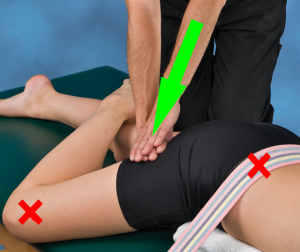 Hip Anterior Glide is used to improve hip extension and external rotation. Anterior glides are performed in prone with the involved leg in a figure-4 position, i.e. draped over the uninvolved leg at the level of the knee. The clinician uses a hand-over-hand contact just below gluteal fold to impart an anterolateral force to the proximal femur.
Hip Anterior Glide is used to improve hip extension and external rotation. Anterior glides are performed in prone with the involved leg in a figure-4 position, i.e. draped over the uninvolved leg at the level of the knee. The clinician uses a hand-over-hand contact just below gluteal fold to impart an anterolateral force to the proximal femur.
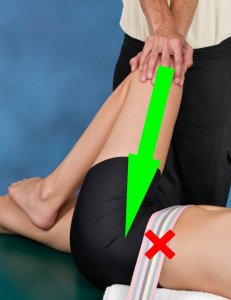 Hip Posterior Glide is used to improve hip flexion and internal rotation. In supine a bolster is placed under the posterior aspect of the involved ischium. The hip is moved into flexion, adduction, and internal rotation, known as the FAdIR position. The clinician clasps their hands over the flexed knee to impart a posterior force through the long axis of the femur.
Hip Posterior Glide is used to improve hip flexion and internal rotation. In supine a bolster is placed under the posterior aspect of the involved ischium. The hip is moved into flexion, adduction, and internal rotation, known as the FAdIR position. The clinician clasps their hands over the flexed knee to impart a posterior force through the long axis of the femur.
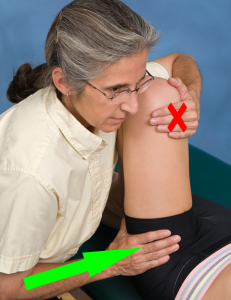 Hip Medial Glide is intended to improve hip abduction and external rotation. To do this, the client assumes a supine position. The hip is in 90 degrees of flexion. The clinician stabilizes the leg by wrapping their arm around the medial knee. A medial force is imparted via contact with the lateral aspect of proximal femur (just distal to the hip joint line). This technique could also be performed in side-lying. It may be a little more challenging to support the weight of the involved limb but the advantage is the medial force is then applied in a downward direct to the lateral aspect of the proximal femur, i.e. with the assistance of gravity.
Hip Medial Glide is intended to improve hip abduction and external rotation. To do this, the client assumes a supine position. The hip is in 90 degrees of flexion. The clinician stabilizes the leg by wrapping their arm around the medial knee. A medial force is imparted via contact with the lateral aspect of proximal femur (just distal to the hip joint line). This technique could also be performed in side-lying. It may be a little more challenging to support the weight of the involved limb but the advantage is the medial force is then applied in a downward direct to the lateral aspect of the proximal femur, i.e. with the assistance of gravity.
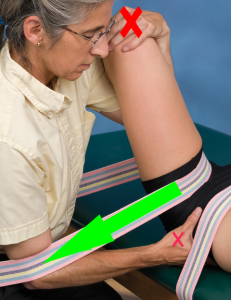 Hip Lateral Glide is performed to improve hip adduction and internal rotation. The client is positioned in supine with and hip flexed to 90° and a strap around the proximal thigh. The leg is stabilized distally at the knee and a counter/stabilization force is applied to the lateral aspect of the iliac crest. Together, these 2 stabilization points are important for a lateral force to be imparted via the strap around the client’s proximal thigh and the clinician’s hips. This force can be achieved through a simple weight shift of the clinician. By leaning back or performing an anterior pelvic tilt, the clinician pushing their butt back and adds tension to the strap to assist the mobilization. Using a mobilization strap can enhance grip, reduce sliding on client’s skin, and accommodate for a size disparity between the client and the clinician.
Hip Lateral Glide is performed to improve hip adduction and internal rotation. The client is positioned in supine with and hip flexed to 90° and a strap around the proximal thigh. The leg is stabilized distally at the knee and a counter/stabilization force is applied to the lateral aspect of the iliac crest. Together, these 2 stabilization points are important for a lateral force to be imparted via the strap around the client’s proximal thigh and the clinician’s hips. This force can be achieved through a simple weight shift of the clinician. By leaning back or performing an anterior pelvic tilt, the clinician pushing their butt back and adds tension to the strap to assist the mobilization. Using a mobilization strap can enhance grip, reduce sliding on client’s skin, and accommodate for a size disparity between the client and the clinician.
For more cutting edge orthopedic information please subscribe to iOrtho+ Premium Web App, please visit https://iortho.xyz/
- Cyriax, JH, Cyriax, PJ: Cyriax’s Illustrated Manual of Orthopaedic Medicine, 2nd Woburn, MA, Butterworth-Heinemann, 1993.
- Greenman, PE. Principles of Manual Medicine, 2nd Baltimore, MD, Lippincott Williams Wilkins, 1996.
- Gulick DT. iOrtho+ Mobile App. DTG Enterprises LLC. 2024
- Gulick, DT. OrthoNotes, 5th FA Davis Publishing, Philadelphia. 2023
- Kaltenborn FM. Manual Mobilization of the Joints: The Kaltenborn Method of Joint Examination & Treatment, Volume I: The Extremities. 6th Oslo, Norway: Olaf Norlis Bokhandel, 2002.
- Maitland GD, Hengeveld E, Banks K, English K. Maitland’s Vertebral Manipulation. 6th Woburn, MA: Butterworth-Heinemann, 2001.
- Maitland GD. Peripheral Manipulation. 3rd Woburn, MA: Butterworth-Heinemann, 1991.
